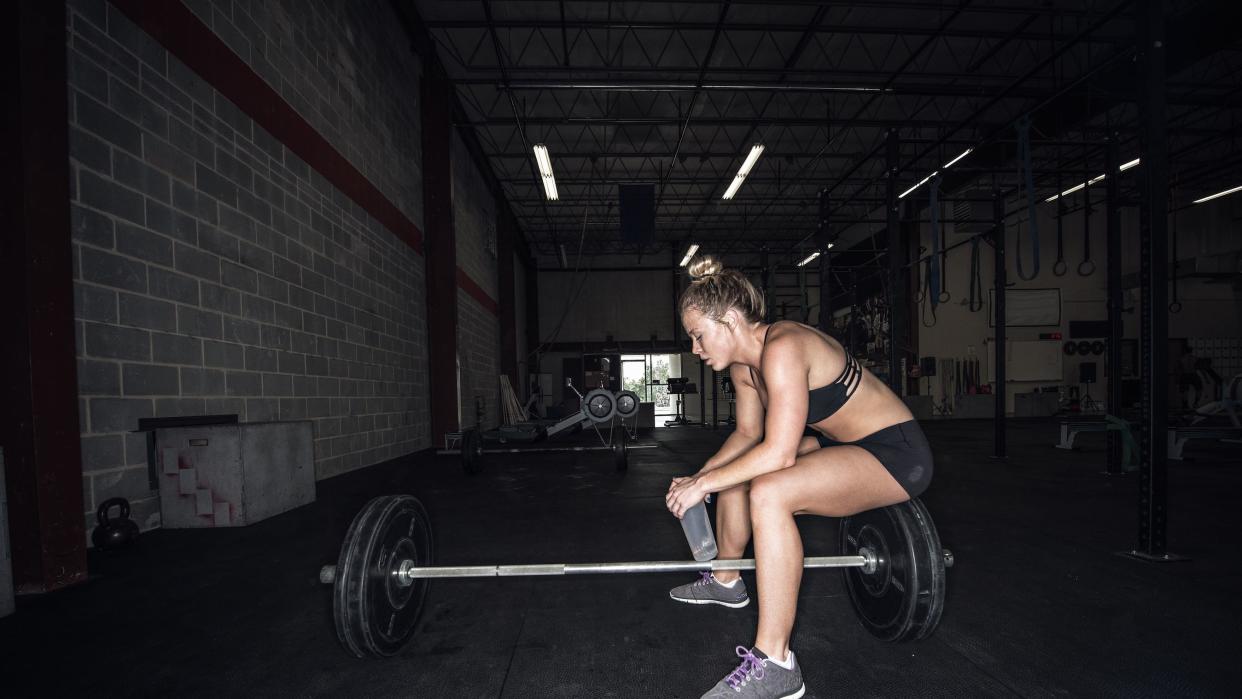CrossFit Athletes Share Their Tips for Dealing with Delayed-Onset Muscle Soreness

Cultura RM Exclusive/Corey Jenkins/Getty Images
There's no better feeling than the one that you get right after you totally slay a workout. Whether it's running or weightlifting, dancing, or cycling, that rush of endorphins can make anyone feel like a total boss. Not as exciting? Next-day soreness.
Delayed onset muscle soreness (or DOMS) is a result of the damage you're inflicting to your muscles on a cellular level. When you work out, your muscles get small micro tears which eventually help them come back bigger and stronger. Don't worry, it's totally normal.
This can be impacted by a lot of different factors, like how heavy of weights you're lifting, how long you're exercising, or even if you're targeting the same muscle group multiple days in a row. As you can imagine, CrossFitters know a thing or two about DOMS. Combining gymnastics, weight training, Olympic weight training, and metabolic conditioning, the workout is no joke.
How do you go back to the box day after day (or even head to the CrossFit Games) without letting DOMS interrupt your workout flow? We sat down with a few of the top ladies at the 2019 Reebok CrossFit Athlete Summit to find out.
1. Make Sleep a Priority
"As soon as I think about recovery, I instantly look at my sleep," says Tia-Clair Toomey, the current "Fittest Woman on Earth," aka most recent winner of the CrossFit Games. "If I can turn around and say okay, I've had a great sleep for the past few nights and I'm still feeling really sore, then I can evaluate elsewhere." On average, the Australian-born athlete aims for seven to eight hours of shuteye each night for optimal performance. When she doesn't hit that amount? She says she almost always experiences an increase in DOMS.
2. Keep a Positive Attitude
It's been long-studied that mood can have a direct impact on how your body handles activity. In one University of Illiniois at Chicago study of 193 healthy adults, people who reported dissatisfaction or symptoms of stress and depression were slower to recover from a small mouth wound than those who didn't.
Lindy Barber, former team member of CrossFit Mayhem Freedom, can definitely attest to this: "Being injured constantly, I was always stressing out and irritable and angry. In turn, I noticed that I was always sore," she confesses. "When I took the time to de-stress, lay on my couch, maybe eat a donut, just relax, breathe, and watch Netflix, I felt better both mentally and physically. Yeah, it's hard to take a break sometimes. But when I'm in a better mood, I recover and perform better." Granted, that's easier said than done.
3. Examine Your Diet
"I can tell a big difference in how my body feels and recovers when my diet consists of mostly whole foods versus when I eat something processed," says Toomey, who says that her usual diet is full of kale, broccoli, eggplant, apples, and other healthy fruits and vegetables. She's right: Healthy whole foods can boost workout recovery and give your body the nutrients it needs to properly recover.
4. Move… Just a Little
"Sometimes, it's best for me to move through my soreness," says Maddie Sturts. "If my quads are sore, sometimes something like yoga and stretching, even a jog, that will help move the lactic acid around and help me recover. With fatigue, though, that's when I really just need to take a break."
Light activity, like the types Sturts leans into, can increase circulation and help the muscles repair faster, according to Polish research. Through movement, key nutrients are delivered to the muscles which can speed up the recovery process.
5. Be Conscious If You're Drinking
"A few drinks can really throw off your training for the days to come," says Barber. "So, I'm smart about when I go for it. Special occasions are one thing, but with training, I think about my decision to drink sometimes in a different way."
Barber has a point: A study published in the European Journal of Applied Physiology found that increased alcohol consumption after resistance training can significantly decrease strength recovery. (Here's how much alcohol you can drink before it starts to mess with your fitness.) Mocktails, anyone?
6. Hit the Sauna
Studies show that infrared heat can reduce chronic pain and lower blood pressure—so it's no wonder why all three of these high-caliber athletes lean into saunas from time to time on their recovery days. "I'll go do a sauna session when I'm feeling sore," says Toomey. "It helps to get the blood flowing in the heat, I feel like things loosen up, and I don't need to move around to make that happen." (Here's more on the possible benefits of infrared sauna treatments.)

